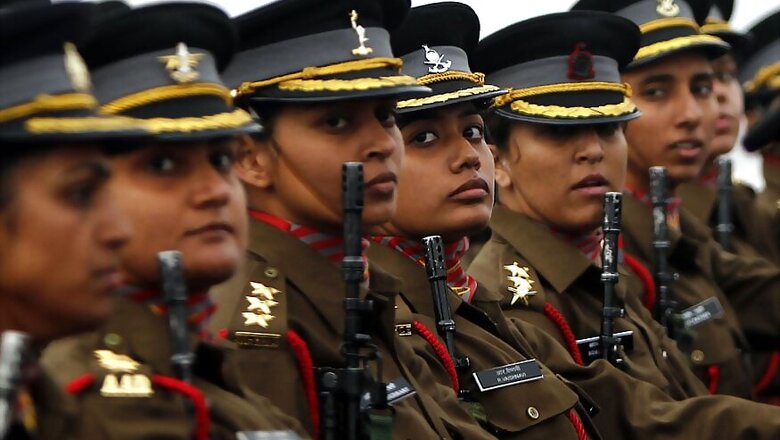
views
New Delhi: As the world continues to see civil wars across continents, experts believe that women, who are considered to have natural affinity for peace, can help fight widespread sexual violence during conflicts.
Experts are of the opinion that women in uniform can help fight the scourge of Conflict-Related Sexual Violence (CRSV).
According to a report, 91 civil wars were waged across the world between 1980 and 2012. In 51 of these civil wars, “widespread sexual violence” was reported. In another 20, there were “isolated reports” of sexual violence. And the world continues to see civil war being waged across continents.
Lt. Gen. (retired) PK Singh, Director of Delhi-based think tank United Services Institutions, said sexual violence is not just a source of subjugation, but is also used to fund rebel groups.
“Armed groups, during times of civil war, use sexual violence as a tactic of war. For example, women are used as human shields by rebel groups in several parts of the world. However, sex trafficking, ransom, forced marriages and other evils are also used to finance terror operations,” Singh said.
According to Ruchi Ghanshyam, Secretary in India’s Ministry of External Affairs (MEA), there is empirical evidence to prove that there is a correlation between gender equality and lowering levels of sexual violence. Moreover, peace, when brokered by women, is more likely to last longer.
“A recent UN study has shown that when women are a part of the peace process in a conflict-ridden society, when they are a part of ceasefire negotiations and post-conflict resolution, peace lasts longer. And yet, women’s participation is low. We need many more women occupying top posts in the UN Peace Mission. This (inclusion of women) is now matter of the UN’s credibility,” Ghanshyam said.
Despite this empirical evidence, participation of women in the UN Peacekeeping Mission continues to be abysmally low.
Currently, United Nations Peacekeeping Forces are engaged in missions in the Central African Republic (CAR), the Democratic Republic of Congo (DR Congo), Iraq, Mali, Nigeria, Somalia, South Sudan and Syria. However, the proportion of women is 3.6% in the military component, 9.6% in the police component and 22% in the civilian component of the mission.
But UN Secretary General Antonio Guterres plans to change that.
The United Nations Entity for Gender Equality and the Empowerment of Women (UN Women) on Monday started a four-day course on Mainstreaming Gender in UN Peacekeeping to end conflict-related sexual violence.
The course saw 38 officers, both men and women, from the military, police and diplomatic services from India, Bangladesh, Bhutan, Canada, Japan, Finland, Sweden, Switzerland, Sri Lanka and the United Kingdom come together and learn how to integrate women in peacekeeping missions, not just as supporters but as active participants.
Lt. General Sarath Chand, Vice-Chief of Army Staff (VCoAs), told News 18 that India was going to double the number of women it currently involves in UN Peacekeeping Missions.
“From deciding the mandate of the peacekeeping missions to negotiating ceasefires and post-conflict resolution, women need to play a larger role. Currently, women constitute fewer than 4% of the military component of peacekeeping missions. The United Nations Secretary General wants it to be 8% by next year. We (Indian Army) have also been instructed to double the number of women at our end and we will keep up our commitments,” the Vice-Chief said.
India is already one of the largest troop contributors to the UN Peacekeeping Force, with 1.8 lakh troops deployed over 43 missions since the inception of the UN Peacekeeping Mission.
Speaking earlier at a ‘UN Women’ event in New Delhi, which is hosting a workshop on gender integration in peacekeeping missions, Lt. Gen. Chand, who has also served on UN peacekeeping missions, recalled horrors of conflict-related sexual violence on the battlefield.
“I have also been a part of UN peacekeeping missions and I have witnessed the suffering of women. Rape and sexual violence are used as tactics of war by rebel groups. This isn’t something that the UN didn’t know. This was happening despite UN resolutions being passed against it,” Chand said.
“More and more, we see the nature of international conflict change. We are moving from inter-state conflict to intra-state conflict,” said Lt. Gen. Chand, adding, “We need to take care that when we include women in peacekeeping missions, they also need to be provided adequate security as part of the mission.”
Currently, women are not allowed to serve in the Indian Army’s combat units like the Infantry, Armored Corps and the Mechanized Infantry. The Indian Army inducted within its ranks a female officer for the first time in 1993. In 2007, the first all-woman United Nations Peacekeeping Force was sent to Liberia, which had 105 Indian policewomen.
















Comments
0 comment